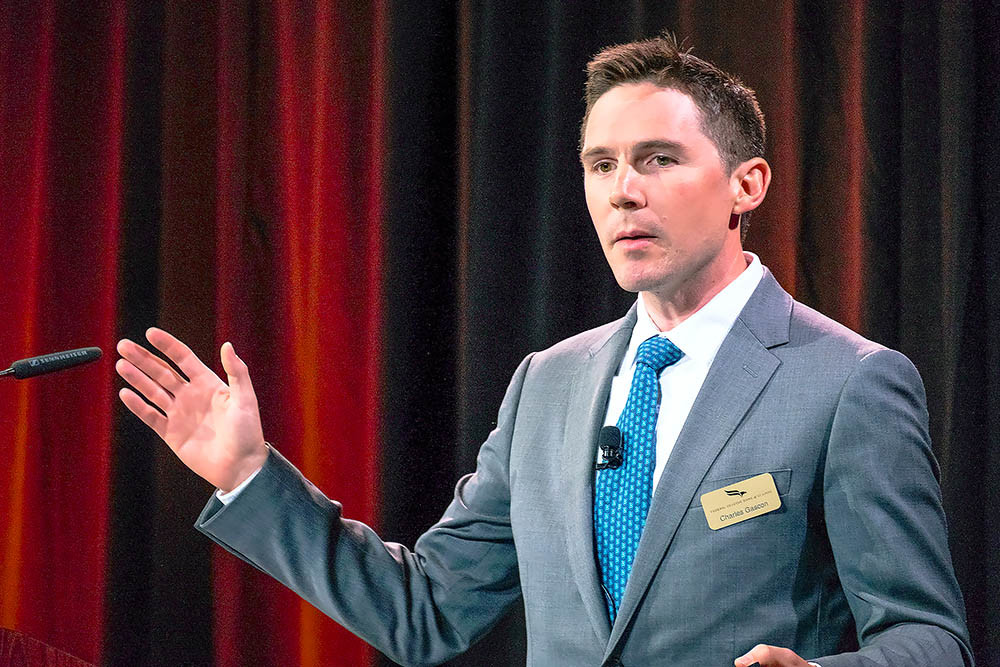YOUR BUSINESS AUTHORITY
Springfield, MO
YOUR BUSINESS AUTHORITY
Springfield, MO

Economists from St. Louis and Kansas City described Springfield’s economy as sturdy, again heralding its low cost of living, during the Springfield Area Chamber of Commerce’s Aug. 23 Economic Outlook event.
Two Federal Reserve Bank officials – Charles Gascon from St. Louis and Craig Hakkio from Kansas City – took the stage at the University Plaza Hotel & Convention Center to show how Springfield stacks up against the rest of the state and the country.
The sticky figure is 12 percent – that’s how much lower the cost of living in Springfield is compared with the U.S. average.
“Those projections are just a little bit lower than it is in St. Louis and Kansas City,” Federal Reserve regional economist Gascon told the crowd of over 100.
In St. Louis, the cost of living is 6 percent under the national average, while Kansas City sits 10 percent below.
The cost of living stat is offset, perhaps presumably, by lower household incomes in Springfield. According to the U.S. Census Bureau, median household income in the Springfield area is $44,786. Nationwide, median income was $55,775 in 2015.
Now, Springfield is the 113th largest metropolitan statistical area in the nation, home to nearly 500,000 people.
Statewide perspective
Springfield’s population, within the last few years, has slowly but steadily grown, Gascon said. Last year’s city population of 167,319 is up from 159,498 in 2010, according to Census Bureau data.
However, growing doesn’t come without costs. He said affordability, congestion and pollution are all issues that accompany population growth – quantified in “unhealthful days.”
An unhealthful day is a day in which the air quality for any of the five major air pollutants – carbon monoxide, nitrogen dioxide, ozone, particulate matter and sulphur dioxide – exceeds an established air quality standard. The average number of unhealthful days surges, for instance, when cities continue to expand.
Springfield’s average number of unhealthful days was recorded at 18 per year, between 2000 and 2015.
“Population and pollution are positively correlated,” Gascon said. “As cities expand, you also have to deal with pollution issues that follow.”
Gascon assured audience members the concern is much greater globally than it is in Missouri and even the United States. Populations with over 1 million people often record over 40 unhealthful days per year.
In addition, a growing city can cause traffic congestion.
“We spend an average of 25 minutes commuting to work,” Gascon told the Springfield businesspeople.
Citing Census Bureau data, he said commuters in Kansas City spend about the same amount of time, while St. Louis residents spend up to half an hour traveling to and from work.
When it comes to employment, last year growth was predicted at 1.8 percent for 2017 in Springfield. Next year, Gascon said the number of people filling open positions in the city should slow.
“The labor market is at – or beyond – full employment,” he said, noting city and business leaders should continue to ask how they can attract workers.
Among the needs are infrastructure for improved internet connectivity and highways, and investment in human capital for education and job training.
“Those are the challenges that the region faces,” Gascon said.
Nationwide statistics
Though it’s moderated in the last five years, Hakkio credited high-skill jobs for employment growth across the country.
“Those tend to be those [that need] higher education and higher creativity,” said Hakkio, a special adviser on economic policy for the Federal Reserve Bank of Kansas City.
Missouri officials have taken notice of this trend. In June, Gov. Eric Greitens created the Innovation Task Force and charged it with assessing the current state of innovation in Missouri, analyzing best practices from other states and developing specific recommendations to promote innovation and new technology startups.
“Accelerating the growth of good-paying jobs is critical to Missouri’s future,” Greitens said in a statement. “Missouri must find smart, efficient ways to support innovation, entrepreneurs and new technology startups.”
Real estate is key to the Springfield community’s competitive edge and opportunity for future business and talent growth, said Justin Coyan, the Springfield chamber’s manager of business development, at the event. Coyan, a third speaker, presented an update on recent successful commercial development projects all enticed by available buildings here that met their needs.
But commercial space isn’t the only thing of importance. Multifamily residential developments seem to be more prominent than ever, Hakkio said.
“After the recession, we saw a big increase in multifamily starts,” he said. “We’re still likely to see a residential investment contributing to growth going forward.”
Multifamily residential developments took up 9 percent of U.S. residential investments in 2016, according to Census Bureau data. Single-family residences took up 35 percent, and 32 percent was spent on home improvements.
Hakkio said consumers would continue to be a driving force of any growth.
A key factor, gross domestic product, is expected to grow at a faster rate in Springfield compared with its Missouri peers. Gascon said Springfield’s GDP per capita is projected to grow at a 2.6 percent rate into 2021, compared with St. Louis and Kansas City, which should grow at rates of 1.7 and 2.3 percent, respectively.
The Springfield Business Development Corp., the chamber’s economic development subsidiary, organized the event as part of its annual Outlook series. The next scheduled event is the Education Outlook on Oct. 4.
Downtown problems partly a product of perception, officials say.
Updated: First Watch business partner sues another for breach of fiduciary duty, fraud
Report: UMB Financial Corp. in talks to make acquisition
Wendy’s franchisee ordered to pay $7M over harassment, PPP fraud accusations
Palm & Paddle Grille aims for mid-June launch
Republic First Bank closed by Pennsylvania regulators